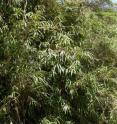A new species of bamboo-feeding plant lice found in Costa Rica
Several periods of field work during 2008 have led to the discovery of a new species of bamboo-feeding plant lice in Costa Rica's high-altitude region "Cerro de la Muerte." The discovery was made thanks to molecular data analysis of mitochondrial DNA. The collected records have also increased the overall knowledge of plant lice (one of the most dangerous agricultural pests worldwide) from the region with more that 20%. The study was published in the open access journal ZooKeys.
It is a well established fact that the arthropod fauna, to which plant lice also belong, is abundantly present in the tropical regions. Not so with plant lice, which prefer the temperate climates of the Northern Hemisphere. This has been a bit of a paradox for scientists although it is also known that plant lice diversity increases in high altitude areas, such as mountains and high plateaus. Such is the sampling area visited in Costa Rica: "Cerro de la Muerte," or The Mountain of the Dead, the highest point in the Costa Rican section of the Inter-American Highway.
Many plant lice species feed only on one type (or even species) of plant; the diet of the newly described plant lice species consists (based on current data), for example, solely of a type of bamboo (Chusquea tomentosa). A molecular analysis was used to determine to which taxonomic genus it belongs (Rhopalosiphum). Its description is based also on molecular information of fragments of the mitochondrial DNA (COI), and on nuclear gene coding, in addition to morphologic external characteristics.
Plant lice are recognized among the biggest insect pests on agriculture and gardening. From a zoological point of view though, they are very successful organisms, which although present mainly in temperate climates, have the potential to threaten even tropical regions, dedicated to plant cultivation.
Source: Pensoft Publishers
Other sources
- New species of bamboo-feeding plant lice found in Costa Ricafrom Science DailyMon, 6 Feb 2012, 18:30:35 UTC
- A new species of bamboo-feeding plant lice found in Costa Ricafrom PhysorgMon, 6 Feb 2012, 16:00:27 UTC

